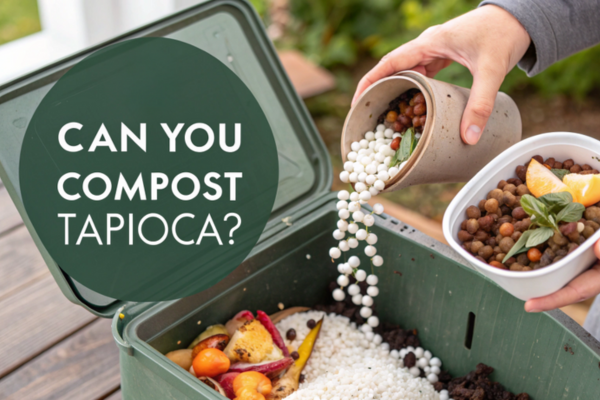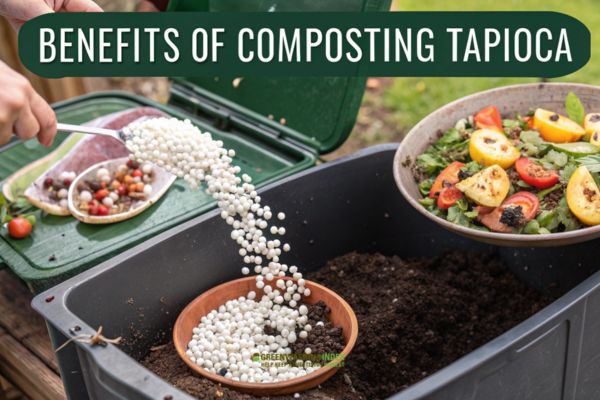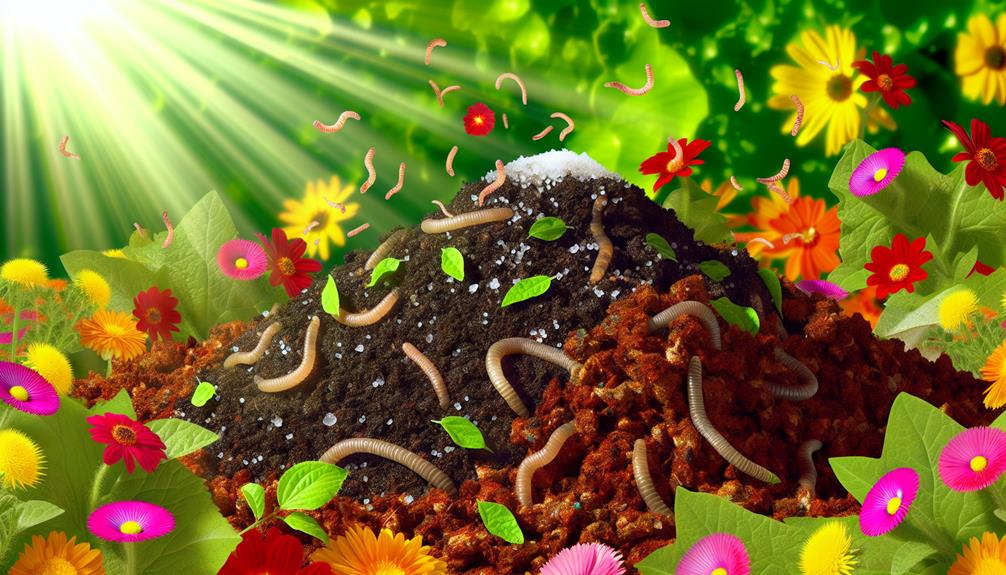

You can compost tapioca, making good use of its high starch content. Start by breaking it into smaller pieces, and make sure it’s clean and peeled. Tapioca enriches your compost, boosting microbial activity and speeding up decomposition. Maintain proper compost conditions: keep moisture like a wrung-out sponge, temperature between 135-160°F, and guarantee good aeration.
Regularly turn the pile and balance with nitrogen-rich materials. In 2-3 months, tapioca should decompose, contributing to rich, dark soil. Watch for any odors, and adjust moisture and aeration as needed. With these tips, you’ll successfully integrate tapioca into your composting routine.
Tapioca, derived from the cassava root, primarily consists of starchy carbohydrates. You might be curious about its origins and nutritional value, especially if you’re considering composting it.
Tapioca has a long history, originating from South America, where indigenous people have cultivated cassava for thousands of years. It’s a staple in many cultures and has found its way into countless recipes worldwide.
When you look at tapioca‘s nutritional value, you’ll notice it’s mainly composed of carbohydrates. This makes it an important energy source but offers little regarding protein, fat, or essential vitamins. While it mightn’t be the most nutrient-dense food, tapioca’s simplicity means it’s gluten-free and easy to digest, making it a popular choice for those with dietary restrictions.
Understanding tapioca’s composition is essential if you’re thinking about composting it. Its high starch content can be beneficial in your compost pile, balancing out nitrogen-rich materials and helping to create a well-rounded compost mix.
Starch plays an essential role in composting by serving as a carbon-rich component that balances the nitrogen-rich materials in your compost pile. When you add starch, like the kind found in tapioca, you provide an important energy source for the microorganisms breaking down your compost. This balance between carbon and nitrogen is vital for efficient decomposition and helps prevent issues like unpleasant odors.
To put it into perspective, starch isn’t just important in composting; it has significant industrial uses as well. It’s used in everything from food products to biodegradable plastics. But in your compost pile, its main job is to break down and contribute to the overall nutritional content of the final compost. By incorporating starch, you’re not only helping the microbial activity but also enriching your compost with essential nutrients.
When you’re composting, aim for a mix of green (nitrogen-rich) and brown (carbon-rich) materials. Starch from tapioca fits perfectly into the brown category. Just make sure to mix it well with other compost materials to guarantee even decomposition. This practice will lead to richer, more fertile compost for your garden.
Also Read: Can You Compost Cat Food?
One of the key benefits of composting tapioca is its ability to enhance the microbial activity in your compost pile, leading to faster and more efficient decomposition. By adding tapioca, you’re providing a rich source of starch that microbes thrive on, which accelerates the breakdown of organic matter.

This active microbial community is essential for sustainable gardening practices, ensuring that your compost pile remains healthy and productive.
When you compost tapioca, you’re also contributing to soil rejuvenation. The nutrients released from decomposed tapioca enrich the compost, which, when added to your garden soil, helps improve soil structure and fertility. This enriched soil supports robust plant growth, giving you healthier and more productive plants.
Moreover, composting tapioca aligns with eco-friendly gardening habits. Instead of sending food waste to a landfill, you’re turning it into valuable compost that can boost your garden’s vitality. This not only reduces your environmental footprint but also creates a sense of community among like-minded gardeners who prioritize sustainability.
While composting tapioca offers numerous benefits, you might encounter some potential issues that could affect the efficiency of your compost pile. It’s important to be aware of these challenges so you can address them proactively and maintain a healthy compost system.
To prepare tapioca for composting, begin by breaking it into smaller pieces to expedite the decomposition process. This ensures that microorganisms can access more surface area, leading to quicker breakdown.
Next, focus on washing tapioca thoroughly. This step removes any dirt or chemicals that might impede the composting process. Clean tapioca will integrate better into your compost mix, promoting a healthier environment for the microorganisms involved in decomposition.
After washing, the next critical step is peeling tapioca. The peel can be tougher and slower to break down compared to the inner starch. By removing the peel, you make the composting process more efficient.
Here’s a quick guide to help you visualize the preparation steps:
| Step | Description |
|---|---|
| Break into Pieces | Chop the tapioca into smaller chunks for faster decomposition. |
| Wash Tapioca | Rinse thoroughly to remove dirt and chemicals. |
| Peel Tapioca | Remove the outer layer to facilitate quicker breakdown. |
| Inspect | Ensure all pieces are clean and properly peeled before adding to compost. |
When you combine tapioca with other compost materials, make sure you balance carbon-rich and nitrogen-rich components.
Use materials like dried leaves or straw for carbon and vegetable scraps or coffee grounds for nitrogen.
Also, watch out for potential contaminants, avoiding materials treated with chemicals.
How do you guarantee your tapioca compost has the appropriate balance of carbon and nitrogen for peak decomposition?
To begin, you need to understand tapioca properties and its nutritional composition. Tapioca, being rich in carbohydrates, primarily adds a carbon source to your compost. However, for successful decomposition, balancing carbon with nitrogen is essential.
To achieve this balance, you should mix tapioca with high-nitrogen materials. Here are some tips to help you:
Guaranteeing that your tapioca compost remains uncontaminated requires careful selection and handling of all added materials. You’ll want to avoid contamination sources like chemically treated food scraps, plastic, or non-organic matter. Stick to organic kitchen waste, untreated yard clippings, and other natural materials to keep your compost clean and effective.
First, always check the origin of your added materials. Even small amounts of pesticides or chemicals can disrupt the composting process. Be vigilant about what goes into your compost pile. For instance, avoid adding glossy paper or any treated wood. These items often contain harmful substances that can compromise your compost.
Risk mitigation also involves proper layering techniques. Mix your tapioca with other compostables in balanced layers. This helps ensure that no single material dominates the pile, which can lead to uneven decomposition and contamination. Regularly turning the compost will further reduce risks by promoting aeration and even breakdown of materials.
Lastly, be mindful of your composting environment. Keep it balanced and monitored to detect any potential contamination early. By maintaining a vigilant approach, you’ll contribute to a healthy, thriving compost community.
To achieve the best results, you should frequently monitor and adjust the moisture, temperature, and aeration levels in your compost. Proper management of these factors guarantees a healthy fermentation process and maintains an ideal soil pH. Here are key aspects to take into account:
Understanding the ideal compost conditions sets the stage for estimating how long it will take for your tapioca scraps to decompose. The decomposition rate of tapioca largely depends on factors like moisture, temperature, and the balance of green and brown materials.
In perfect conditions—think a well-aerated compost pile with a balance of nitrogen-rich greens and carbon-rich browns—tapioca can decompose in about 2 to 3 months.
First, make sure your compost pile maintains a temperature between 135-160°F. This heat accelerates the breakdown process. Regularly turning the compost pile will also help by introducing oxygen, which speeds up decomposition. Keep the pile moist but not waterlogged. A good rule of thumb is to aim for the consistency of a damp sponge.
You’ll want to chop or break down larger tapioca pieces before adding them to the pile. Smaller pieces decompose faster, giving you a more accurate time estimation.
Also Read: Can You Compost Cabbage?
To know your tapioca compost is ready, look for rich, dark soil that crumbles easily.

You should verify that there are no foul odors; a pleasant, earthy smell indicates proper decomposition.
Confirm that the mixture is uniform, with no large, recognizable pieces of tapioca remaining.
A sure sign of successful tapioca composting is the formation of rich, dark soil that crumbles easily in your hands. This type of soil is teeming with beneficial soil microbes that play an important role in nutrient cycling. When these microbes break down organic matter like tapioca, they release essential nutrients back into the soil, creating the perfect environment for plants to thrive.
To identify when your compost is ready, look for:
Having a compost pile that reaches this stage means you’re contributing to a sustainable gardening practice. You’re not just recycling kitchen scraps; you’re fostering a community of microorganisms that keep the cycle of life turning.
Besides the rich, dark appearance of well-decomposed compost, another clear indicator of success is the absence of foul odors. When your compost pile is well-maintained, it should emit a pleasant, earthy scent rather than a repelling stench. This is where smell reduction and odor management come into play.
First, make sure your compost has the right balance of green (nitrogen-rich) and brown (carbon-rich) materials. Greens include kitchen scraps like vegetable peels and tapioca, while browns consist of items like dry leaves and paper. Maintaining this balance helps in reducing unpleasant smells.
Second, turn your compost pile regularly. Aerating your compost introduces oxygen, which is essential for the microbes breaking down the organic matter. Proper aeration plays a significant role in odor management by preventing the anaerobic conditions that cause foul smells.
Lastly, monitor the moisture level. Your compost should be as damp as a wrung-out sponge. Too much moisture can lead to slimy conditions that promote bad odors, while too little can slow down the decomposition process.
Also Read: Can You Compost Celery?
Instead of composting, you can consider several alternative methods for disposing of tapioca waste. Utilizing industrial uses for tapioca disposal can be an effective way to manage waste responsibly.
Many industries, especially in food processing, can repurpose tapioca. Here are some options to explore:
Yes, tapioca can attract pests when composted, but with proper pest management and monitoring the decomposition rate, you’ll be fine. Stay vigilant and make sure your compost is balanced to keep your garden community thriving.
Yes, you can safely compost tapioca used in bubble tea. It doesn’t pose food safety risks and helps reduce environmental impact. By composting, you’re contributing to a greener community and fostering a sense of environmental responsibility.
Tapioca’s impact on compost pH is minimal, so you don’t need to worry. It actually boosts microbial activity and nutrient contribution, helping you create rich compost. Your efforts truly make a difference in our shared environment.
You can compost cooked tapioca! Its nutrient content aids soil health, and its decomposition rate is relatively fast. Including cooked tapioca in your compost helps create a richer, more vibrant garden community. Give it a try!
You don’t need specific compost bins for tapioca disposal. Any standard compost bin will work just fine. Just make sure to balance it with other compostable materials, and you’ll be part of the eco-friendly community in no time!
You can definitely compost tapioca. Prepare it by breaking it into smaller pieces to speed up decomposition. Make sure your compost pile is balanced with a mix of greens and browns, maintaining proper moisture and aeration.
Keep an eye on the pile for signs of successful composting, like a rich, earthy smell and crumbly texture. If composting isn’t an option, consider other disposal methods like feeding it to animals or using it as mulch.

Don't let aphids, slugs, and caterpillars ruin another plant. Take back control with simple, natural methods that actually work.